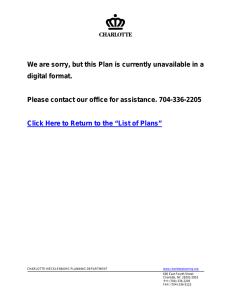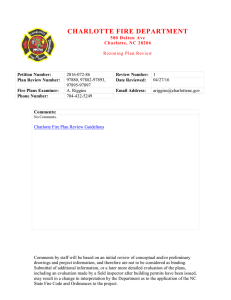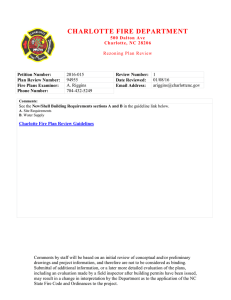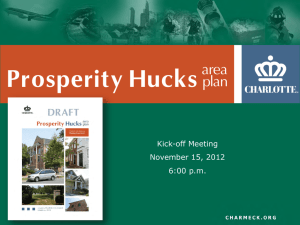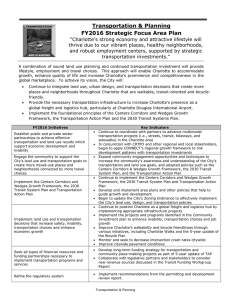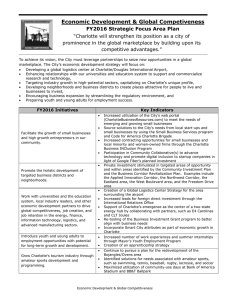“Charlotte will be one of America’s safest communities.” Community Safety
advertisement
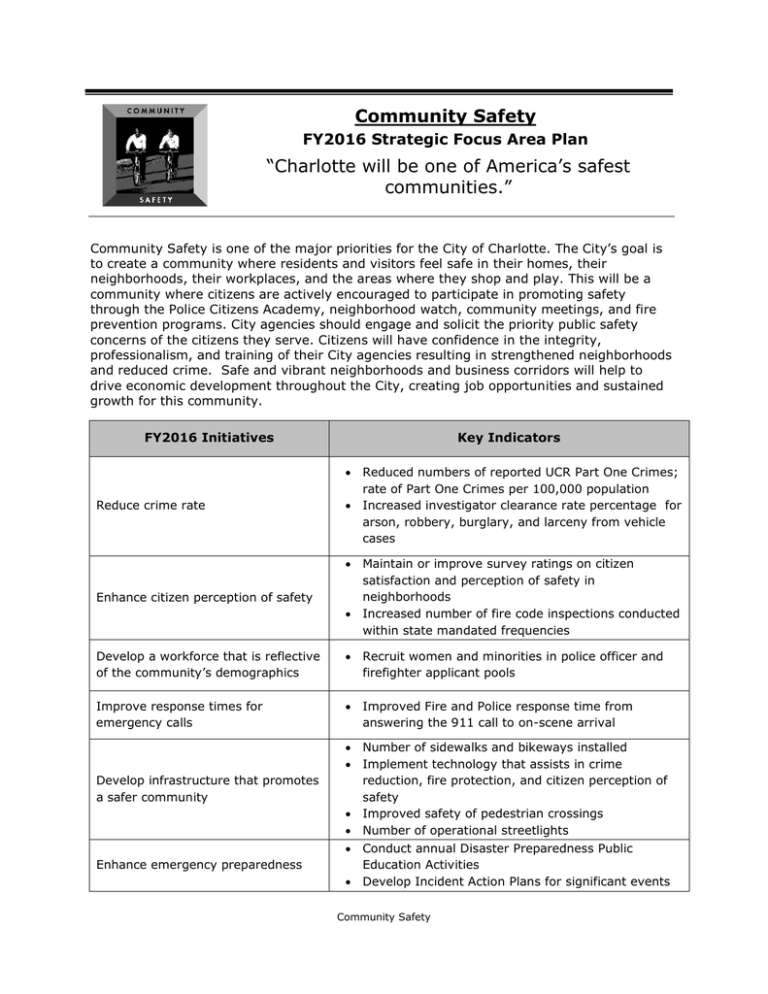
Community Safety FY2016 Strategic Focus Area Plan “Charlotte will be one of America’s safest communities.” Community Safety is one of the major priorities for the City of Charlotte. The City’s goal is to create a community where residents and visitors feel safe in their homes, their neighborhoods, their workplaces, and the areas where they shop and play. This will be a community where citizens are actively encouraged to participate in promoting safety through the Police Citizens Academy, neighborhood watch, community meetings, and fire prevention programs. City agencies should engage and solicit the priority public safety concerns of the citizens they serve. Citizens will have confidence in the integrity, professionalism, and training of their City agencies resulting in strengthened neighborhoods and reduced crime. Safe and vibrant neighborhoods and business corridors will help to drive economic development throughout the City, creating job opportunities and sustained growth for this community. FY2016 Initiatives Key Indicators Reduce crime rate • Reduced numbers of reported UCR Part One Crimes; rate of Part One Crimes per 100,000 population • Increased investigator clearance rate percentage for arson, robbery, burglary, and larceny from vehicle cases Enhance citizen perception of safety • Maintain or improve survey ratings on citizen satisfaction and perception of safety in neighborhoods • Increased number of fire code inspections conducted within state mandated frequencies Develop a workforce that is reflective of the community’s demographics • Recruit women and minorities in police officer and firefighter applicant pools Improve response times for emergency calls • Improved Fire and Police response time from answering the 911 call to on-scene arrival Develop infrastructure that promotes a safer community Enhance emergency preparedness • Number of sidewalks and bikeways installed • Implement technology that assists in crime reduction, fire protection, and citizen perception of safety • Improved safety of pedestrian crossings • Number of operational streetlights • Conduct annual Disaster Preparedness Public Education Activities • Develop Incident Action Plans for significant events Community Safety Economic Development & Global Competiveness FY2016 Strategic Focus Area Plan “Charlotte will strengthen its position as a city of prominence in the global marketplace by building upon its competitive advantages.” To achieve its vision, the City must leverage partnerships to seize new opportunities in a global marketplace. The City’s economic development strategy will focus on: • Developing a global logistics center at Charlotte/Douglas International Airport, • Enhancing relationships with our universities and education system to support and commercialize research and technology, • Targeting industry growth in high-potential sectors, capitalizing on Charlotte’s unique profile, • Developing neighborhoods and business districts to create places attractive for people to live and businesses to invest, • Encouraging business expansion by streamlining the regulatory environment, and • Preparing youth and young adults for employment success. FY2016 Initiatives Key Indicators • • Facilitate the growth of small businesses and high growth entrepreneurs in our community. • • • Promote the holistic development of targeted business districts and neighborhoods. • Work with universities and the education system, local industry leaders, and other economic development partners to drive global competitiveness, job creation, and job retention in the energy, finance, information technology, logistics, and advanced manufacturing sectors. Introduce youth and young adults to employment opportunities with potential for long-term growth and development. • • • • • • • Grow Charlotte’s tourism industry through amateur sports development and programming. • • Increased utilization of the City’s web portal (CharlotteBusinessResources.com) to meet the needs of emerging and growing small businesses Source solutions to the City’s needs from local start-ups and small businesses by using the Small Business Services program and Code for America Charlotte Brigade Increased contracting opportunities for small businesses and local minority and women-owned firms through the Charlotte Business INClusion Program Participation in Community Collaborative(s) to advance technology and promote digital inclusion to startup companies in light of Google Fiber’s planned investment Private investment stimulated in targeted areas of opportunity and within areas identified by the Community Investment Plan and the Business Corridor Revitalization Plan. Examples include the Applied Innovation Corridor, the Northwest Corridor, the Eastland area, the West Boulevard area, and the Freedom Drive area Creation of a Global Logistics Center Strategy for the area surrounding the airport Increased leads for foreign direct investment through the International Relations Office Support of Charlotte’s emergence as the center of a two-state energy hub by collaborating with partners, such as E4 Carolinas and CLT Joules Re-tooling of the Business Investment Grant program to better align with business needs Incorporate Smart City attributes as part of economic growth in Charlotte Increased number of work experiences and summer internships through Mayor’s Youth Employment Program Creation of an apprenticeship strategy Continue to pursue a plan for the redevelopment of the Bojangles/Ovens area Identified solutions for needs associated with amateur sports, such as swimming, tennis, baseball, rugby, lacrosse, and soccer Maximized utilization of community-use days at Bank of America Stadium and BB&T Ballpark Economic Development & Global Competitiveness Environment FY2016 Strategic Focus Area Plan “Charlotte will become a global leader in environmental sustainability, preserving our natural resources while balancing growth with sound fiscal policy.” The City of Charlotte recognizes that environmental stewardship is fundamentally important to quality of life and essential to maintaining a vibrant economy. Protecting our natural resources, promoting conservation, and improving the environment all enhance the City’s mission to preserve its citizens’ quality of life. Charlotte will become a global leader in environmental sustainability by: • Becoming a model environmental community in how it manages solid waste, energy, water and air; • Leading by example by practicing environmental stewardship in City operations and facilities as directed through the Internal Environmental Operations Plan; • Seeking and supporting collaborative and regional solutions to environmental problems; • Applying technologies to develop “smart city” solutions to our environmental goals. Specific initiatives to support these goals include: FY2016 Initiatives Waste Energy • • Water • • Air • • Smart City • FY2016 Initiatives Waste • Energy • • Water • Air • Smart City • Key Indicators – Community Develop baseline towards 100% achievement of waste diversion from landfill Develop baseline towards achieving carbon neutral footprint for the community Develop baseline towards reducing potable water use per capita Develop baseline towards making all Charlotte waterways swimmable and fishable Develop baseline towards achieving 50% tree canopy Develop a baseline towards 100% of households located within a 5 minute walk of a transit option by 2050 Develop the Happiness Index for Charlotte Key Indicators – City Organization Develop baseline towards achievement of 100% waste diversion from the landfill Develop baseline towards achievement of carbon neutral footprint for City operations Develop baseline toward 100% LEED certified or equivalent government Develop baseline towards using water as efficiently as possible Develop baseline towards increasing alternative fuel and vehicle technology use Develop baseline towards creating an engaged and connected workforce Environment Housing & Neighborhood Development FY2016 Strategic Focus Area Plan “The City of Charlotte will sustain and create distinct and diverse neighborhoods for residents of all ages.” The City’s long-term health and vitality are dependent on a built environment offering diverse housing options, vibrant commercial corridors, and access to safe public amenities. The City’s housing and neighborhood strategy focuses on preserving and creating neighborhoods and amenities that allow people to reach their full potential by creating places where: • People and businesses are safe, • Civic infrastructure supports neighborhood quality of life, and • Families have access to quality affordable housing, education, jobs, and services. FY2016 Initiatives Preserve and create healthy, vibrant, and distinct neighborhoods Coordinate public/private partnership investments to attract the amenities neighborhoods need Market housing programs to achieve geographical dispersion of diverse housing options throughout the City • • • • • • • • • • Utilize the Quality of Life Study and open data to inform and guide strategic neighborhood investments and programs • • Support partners and programs that enhance opportunity for economic mobility • • • • Key Indicators Correct 90% of nuisance violations within 30 days Assist neighborhoods in developing and implementing strategic plans during annual neighborhood board retreats, neighborhood matching grants, and other partnerships Continue implementing the Comprehensive Neighborhood Improvement Program as outlined in the Community Investment Plan Continue implementing the 2014 Community Investment Plan projects Leverage public/private investments and support of small business within the business corridors through the use of the Community Investment Plan and Business Corridor funds Promote internet access in all neighborhoods Increase number of developer inquiries and approvals for the new voluntary single and multi-family density bonus programs Allocate Housing Trust Fund dollars to developments consistent with Housing Policy goals Continue implementation of the Ten-Year Plan to End and Prevent Homelessness initiatives Use the Quality of Life data to: - Assess Neighborhood Profile Areas, - Enhance and develop programs in partnership with neighborhoods and community organizations, and - Develop Neighborhood Profile Areas composites to develop programs to assist with common reoccurring neighborhood issues Support neighborhood organizations in setting and meeting neighborhood improvement goals through the annual board retreats and the Service Area Teams Engage neighborhoods to identify and prioritize projects within the Comprehensive Neighborhood Improvement Program Support quality out of school time for youth from low income families Support youth connections to mentors, work, and community Support projects and programs that address the digital divide Engage organizations to provide apprenticeships, mentoring relationships, and work experiences Housing & Neighborhood Development Transportation & Planning FY2016 Strategic Focus Area Plan “Charlotte’s strong economy and attractive lifestyle will thrive due to our vibrant places, healthy neighborhoods, and robust employment centers, supported by strategic transportation investments.” A combination of sound land use planning and continued transportation investment will provide lifestyle, employment and travel choices. This approach will enable Charlotte to accommodate growth, enhance quality of life and increase Charlotte’s prominence and competitiveness in the global marketplace. To achieve its vision, the City will: • • • Continue to integrate land use, urban design, and transportation decisions that create more places and neighborhoods throughout Charlotte that are walkable, transit-oriented and bicyclefriendly. Provide the necessary transportation infrastructure to increase Charlotte’s presence as a global freight and logistics hub, particularly at Charlotte Douglas International Airport. Implement the foundational principles of the Centers Corridors and Wedges Growth Framework, the Transportation Action Plan and the 2030 Transit Systems Plan. FY2016 Initiatives Establish public and private sector partnerships to achieve effective transportation and land use results which support economic development and livability Engage the community to support the City’s land use and transportation goals to create more mixed-use places and neighborhoods connected by more travel choices Implement the Centers Corridors and Wedges Growth Framework, the 2030 Transit System Plan and Transportation Action Plan • • • • • • • Implement land use and transportation decisions that increase safety, livability, transportation choices and enhance economic growth • • • • Seek all types of financial resources and funding partnerships necessary to implement transportation programs and services Refine the regulatory system • • • Key Indicators Continue to coordinate with partners to advance multimodal transportation projects (i.e., streets, transit, bikeways, and sidewalks) in the Charlotte area In conjunction with CRTPO and other regional and local stakeholders, begin to apply CONNECT’s regional growth framework to link development patterns with transportation investments Expand community engagement opportunities and techniques to increase the community’s awareness and understanding of the City’s transportation and land use goals, and adopted policies such as the Centers Corridors & Wedges Growth Framework, the 2030 Transit System Plan, and the Transportation Action Plan Continue to implement the Centers Corridors and Wedges Growth Framework, the 2030 Transit System Plan and Transportation Action Plan Develop and implement area plans and other policies that help to guide growth and development Begin to update the City’s Zoning Ordinance to effectively implement the City’s land use, design, and transportation policies Continue to position Charlotte as a global freight and logistics hub by implementing appropriate infrastructure projects Implement the projects and programs identified in the Community Investment plan to enhance livability, transportation choices and job growth Improve Charlotte’s walkability and bicycle-friendliness through various initiatives, including Charlotte Walks and the 5-year update of the Bicycle Plan Monitor and seek to decrease intersection crash rates citywide Improve citywide pavement conditions Develop long-term funding strategy for transportation and community place-making projects as part of 5-year update of TAP Collaborate with legislative partners and stakeholders to consider new revenue sources discussed in the Transit Funding Workgroup Report Implement recommendations from the permitting and development review report. Transportation & Planning
